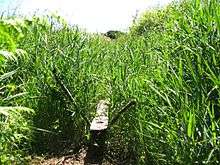Timber trackway

A timber trackway is a simple raised wooden walkway used as the shortest route between two places in a bog or peatland. They have been built for thousands of years as a means of getting between two points.[1][2] Timber trackways have been identified in archaeological finds in Neolithic England, dating to 500 years before Stonehenge. Radiocarbon methods date them to be about 6,000 years old.
Chronological development of corduroy trackways[3]
The earlier corduroy trackways are in Germany and Holland. They date to approximately 3000 BC. Their construction is consistently between 3.5 m and 4 m wide, and are simple structures without pegs. The Lindholme Trackway[4] is later and dates to around 2900-2500 BC. The construction for these is mostly 3 m, and occasionally up to 4 m, wide. Two possible pegs. Later corduroy trackways include the one in Cloonbony, Ireland. This dates to around 2630–2470 BC. The construction of this is 2.5 m wide (with the rails at 1.2 m apart). This is a more complex structure, pegged at intervals.
The Lindholme Trackway fits within a trend of narrowing and increased sophistication during the third millennium BC. It has been argued that this shift could relate to the growing complexity of wheeled transport at the time.
See also
- Boardwalk
- Corduroy road
- Duckboards
- Marsden Matting - a 20th-century equivalent for airport runways
- Plank road
- Post Track
- Sweet Track - one of the oldest engineered roads discovered and the oldest timber trackway discovered in Northern Europe.
- Ancient trackway
- Trackway
References
- ↑ Dig Diary University of Birmingham
- ↑ Peatlands – Northern Ireland Environment Agency
- ↑ Chapman, Henry. "A Neolithic Trackway on Hatfield Moors – a significant discovery" (PDF). Thorne and Hatfield Moors Conservation Forum. Retrieved 20 August 2014.
- ↑ Whitehouse, Nicki (ed). "Thorne and Hatfield Moors Conservation Forum Publications - Papers Volume 7". Thorne and Hatfield Moors Conservation Forum. Thorne and Hatfield Moors Conservation Forum. Retrieved 20 August 2014.
External links
- Neolithic wooden trackways and bog hydrology
- Timber features - trackways and logboats
- Digging a medieval trackway in ceredigion
- A medieval timber trackway and industrial complex at llangynfelyn, Cors Fochno
- Timber trackway 500 years older than Stonehenge found by archaeologists
- Timber structure older than Stonehenge found: Radiocarbon dating shows London platform is about 6,000 years old
- London's Earliest Timber Structure Found During Belmarsh Prison Dig
- A prehistoric timber trackway
- London's Oldest "Boardwalk" Found?
- Medieval trackway and Roman smelting?